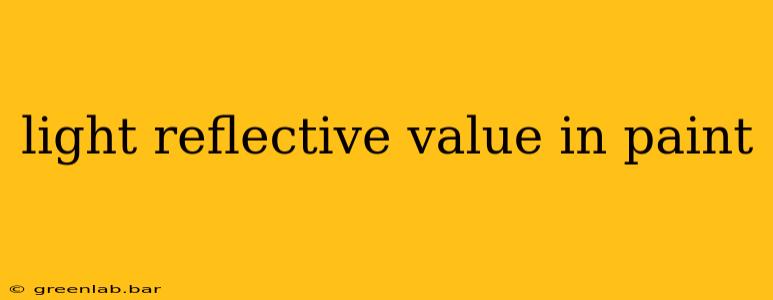Choosing the right paint color can significantly impact the look and feel of your space. Beyond aesthetics, understanding Light Reflective Value (LRV) is crucial for creating the perfect ambiance and maximizing natural light. This comprehensive guide will delve into the importance of LRV in paint selection, helping you make informed decisions for your next painting project.
What is Light Reflective Value (LRV)?
Light Reflective Value (LRV) is a measurement of how much visible and usable light a surface reflects. Expressed as a percentage, it ranges from 0% (total absorption of light, appearing as black) to 100% (total reflection of light, appearing as pure white). A higher LRV indicates a lighter color that reflects more light, while a lower LRV indicates a darker color that absorbs more light.
This seemingly simple metric has a profound impact on the perceived brightness, spaciousness, and even the temperature of a room.
Why is LRV Important in Paint Selection?
Understanding LRV is vital for several reasons:
1. Brightness and Ambiance:
The most immediate effect of LRV is on the brightness of a room. High-LRV paints create bright, airy spaces, ideal for smaller rooms or areas with limited natural light. Lower-LRV paints, conversely, create a more intimate, cozy atmosphere, perfect for larger rooms or spaces where a dramatic feel is desired.
2. Space Perception:
Light colors with high LRV values can make a room feel larger and more spacious. This is because the reflected light expands the visual perception of the area. Conversely, dark colors with low LRV values can make a room feel smaller and more enclosed.
3. Temperature Regulation:
LRV also influences the temperature of a room. Lighter colors reflect sunlight, keeping the space cooler, while darker colors absorb heat, leading to warmer temperatures. This is particularly relevant in areas with intense sunlight.
4. Energy Efficiency:
High-LRV paints can contribute to energy efficiency by reflecting sunlight and reducing the need for artificial lighting and air conditioning.
How to Use LRV in Your Painting Projects:
- Small Rooms: Opt for paints with high LRV values (60% and above) to create a sense of spaciousness and brightness.
- Large Rooms: You have more flexibility. High LRV paints maintain brightness, while lower LRV paints can add depth and drama.
- North-Facing Rooms: Choose paints with high LRV values to compensate for the lack of direct sunlight.
- South-Facing Rooms: Consider medium to high LRV values to balance the abundance of sunlight and prevent overheating.
- Accent Walls: Use lower LRV paints to create a focal point and add visual interest.
Pro Tip: Always check the paint manufacturer's information for the specific LRV of the chosen color. This information is usually available on the paint label or the manufacturer's website.
LRV and Interior Design Styles:
LRV plays a significant role in various interior design styles:
- Minimalist: High LRV paints are a staple, promoting clean lines and a sense of spaciousness.
- Scandinavian: High LRV whites and pastels are commonly used to maximize natural light.
- Bohemian: A mix of high and low LRV values creates a layered, eclectic feel.
- Industrial: Low to medium LRV colors like grays and blacks contribute to the raw aesthetic.
Conclusion:
Understanding Light Reflective Value is a crucial element in successful interior painting projects. By considering the LRV of your paint colors, you can significantly impact the atmosphere, spaciousness, and even energy efficiency of your space. So, next time you're selecting paint, don't overlook this often-overlooked but vital specification. Choosing the right LRV can transform your space from ordinary to extraordinary.

